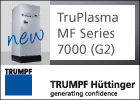The establishment of global standards governing the reduction of CO2 emissions and lack of measurement processes are materially impacting the glass manufacturing industry.
The flat glass melting process used in manufacturing glass products is extremely energy-intensive, especially for large furnaces based on regenerative technology.
According to the U.S. Department of Energy, approximately 40% of the energy used involves heating the batch and homogenising batch constituents; 30% can be lost through the furnace structure, and another 30% can be lost through the exhaust gases.
Glass melting occurs in continuously operated melting furnaces or tanks where a mixture of cold ingredients, including silica sand, limestone, soda ash, dolomite and cullet, is melted at 1600° C (2900° F). The process of melting the glass can take days.
Typically, the higher the quality of glass produced, the longer the residence time of the glass melt to ensure complete homogenisation. The batch in the tank is between two feet (600mm) and three feet (1,000mm) deep.
Key features of furnaces are adequate insulation, good sealing to minimise air leakage, excellent heat recovery from efficient regenerators, a well-designed doghouse and charging system, and an accurate control system.
Globally, the increased focus on emission control and energy consumption is driving glass producers to consider how to get started on the road to decarbonisation.
If moving to oxyfuels, converting fuel or optimising combustion to reduce CO2 emissions, thermal imaging is a key tool to consider in a glass plant’s decarbonisation toolbox.
As a thermal imaging supplier, we have some challenges to consider:
How can we support the operator’s team to produce good glass with the right energy balance reinforcing the existing tools?
How can we optimise the energy balance by seeing the flames and the hot spot locations with thermal systems?
Is an in-furnace thermal survey the starter to optimise combustion and reduce emissions?
The experience to date is that in-furnace thermal imaging works with the combustion of all fuels and oxidants. Plus, in glass melting applications with electric boost, the combustion thermal profile can be optimised to enhance the glass convection flows.
Our NIR Borescope (NIR-B 2K) thermal imaging system delivers this new approach. The short wavelength, radiometric infrared borescope imaging camera produces high-definition (3 million pixels) thermal images and enables accurate temperature measurement from any point in the image. The camera measures temperatures from 600° C to 1800° C (1112° F to 3272° F). There are many advantages to thermal vs visual imaging and point temperature measurements. Using a permanently installed thermal imaging camera that actively records all points, it is possible to have additional virtual thermocouple points and 100 regions of interest (ROI), including profile lines.
If a temperature alarm is triggered, then in addition to an output to the DCS, a snapshot of the condition is taken, providing an opportunity to review any incident.
Most measurements should be taken when the best operation is experienced, so there is a point of reference when things are optimal.
The float glass process has a residence time of up to 3 days. When quality deteriorates at cold inspection, it may take that length of time to recover or longer if you have to find the source or the root cause.
The idea is to create thermal images that can be analysed by all specialists and experts in the glass team to draw practical conclusions.
An additional route is to use the thermal imaging system for in-furnace thermal surveys, using existing peep holes in a float furnace. This approach has many benefits:
Identify sources of parasitic air which, when repaired, lower NOx emissions, optimise energy and potentially extend furnace life
Identify thermal profile and furnace in-balance to improve pull/quality, lower NOx emissions and potentially extend furnace life
Identify potential locations for a static thermal imaging system in the future
Validate CFD models
Analyse combustion to optimise flame coverage to improve pull/quality and reduce refractory wear and extend furnace life and reduce NOx by identifying which burners have the highest intensity and generate thermal NOx
Analyse regenerator and port neck to confirm any in-balance, identify blockages/damage and potentially recover pull and extend furnace life
Identify the timing of the reversal
Determine the right locations to inspect and monitor
Position the instrument safely on the floor with sufficient hose length to reach the peep site
Check cooling water going to drain and inspect at tundish to ensure no kinks in the hoses
Check sufficient air purge
Start recording
Ideally, install >2minutes before reversal, capture reversal and remove
When flames fully developed at +5minutes, take a further recording
Check data immediately to ensure camera and temperatures are acceptable
Keep air maintained to keep instrument cool
In-furnace thermal surveys could support and reinforce the optimisation of furnaces for combustion purposes, flames, and a better understanding of energy balance. Please get in touch to learn more about adding thermal imaging to a glass plant’s decarbonisation toolbox.

























